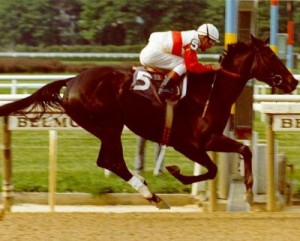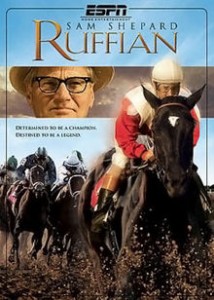The Tragic Tale of Ruffian
It was 36 years ago today that an event created to be a celebration of horse racing greatness turned tragic and resulted in the death of one of the top female racehorses of all-time.
A coal black filly with champion blood lines that included Native Dancer and Bold Ruler, Ruffian had no equals during her two year racing career and was U.S. Filly Champion as a two and three year old.
In 10 career races, Ruffian was never defeated and in 1975 claimed the Filly Triple Crown (now called the Triple Tiara). She established a new record in eight different stakes races, seven of which still stand.
Her dominating victories against female horses led many to wonder if she was capable of competing with the top male horses of her time.
This led on July 6, 1975 to a match-race between Ruffian and 1975 Kentucky Derby winner Foolish Pleasure at Belmont Park. Coming only two years after the Billie Jean King-Bobby Riggs “Battle of the Sexes”, the race was promoted as a chance for America’s finest filly to show her overall dominance in the “Equine Battle of the Sexes”.
Interestingly, jockey Jacinto Vasquez was the primary rider for both horses, but chose to ride Ruffian for the match race and many experts fully expected Ruffian to pull off the victory.
Ruffian ran the first quarter mile in 22 1/5 seconds to take the early lead. However, less than a quarter mile later both of the sesamoid bones in her right foreleg snapped. Vasquez tried to pull her up, but the filly wouldn’t stop running and kept grinding the bones, which eventually broke through the skin and left her hoofs dangling.
A team of veterinarians and an orthopedic surgeon immediately attended to the filly and she underwent extensive surgery to try and repair the damage. However, when the anesthesia had worn off, she began thrashing wildly in the padded cast as if she were still running the race. She eventually smashed the heavy plaster cast and did more damage to her injured leg.
Because the damage was now worse than the original injury, the decision was eventually made to euthanize Ruffian. She is buried near a flag pole at Belmont Park with her nose pointed toward the finish line.
While some wanted to blame the strain of racing against Foolish Pleasure as the reason for her injury, it actually seems that bloodlines were likely to blame. Both her sire, Reviewer, and dam, Shenanigans, suffered multiple broken bones in their legs and were both eventually euthanized due to their injuries.
Ruffian herself had suffered a hairline fracture in one of her hind legs during the 1974 Spinaway Stakes.
Following Ruffian’s injury and reaction to the surgery, there was a public outcry for more humane treatment of horses. A “recovery pool” was soon developed so that when horses awake following surgery they are suspended in warm water and don’t re-injure themselves.
Though Ruffian technically lost her final race, even Foolish Pleasures trainer, Leroy Jolley, believed that had there not been an injury that Ruffian would have come out victorious.
Ruffian was ranked as the 35th greatest thoroughbred of the 20th Century and was the only non-human named as among the top 100 female athletes of the 20th Century, ranking 53rd.
Her story was told in the 2007 movie named Ruffian.


Wow ! This is a beatifule !
Hi! Do you know if they make any plugins to safeguard against hackers?
I’m kinda paranoid about losing everything I’ve worked hard on.
Any recommendations?
My site; business ideas
Tragic tale of the man has been supportively told to all students as a fairy tale. Cultural features and ingredients have been ensured for the good and further successive terms for the people.